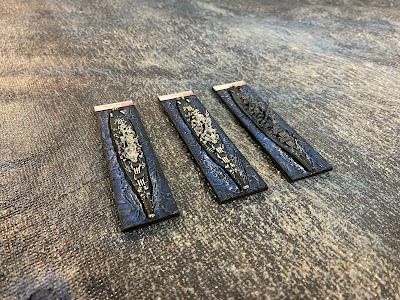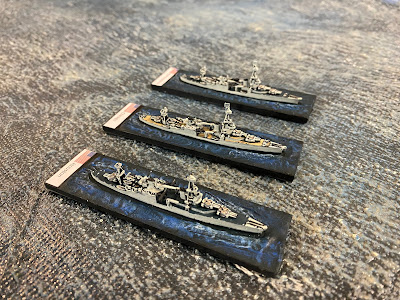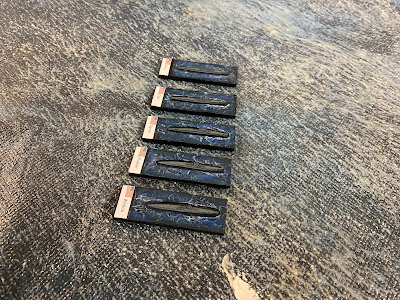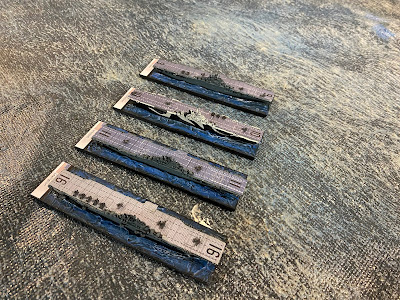Following on from my earlier promise not to drag out too many posting for this project lest I turn this into a naval wargaming blog, here are the recently-completed sixty-nine ships comprising my US Navy fleet.
First off, three Iowa class battleships in the Iowa, Missouri and New Jersey. I have always thought this is one of the most beautifully designed classes of battleships and they are the most expensive under the Nimitz rule system at 48 points each, compared to the Yamato's 45 points and an average of around 35 points for most other battleships. It was a particularly memorable experience to be able to spend an hour or so fossicking through the Missouri in Pearl Harbour a few years ago:
The South Dakota, seen here with her sisters Indiana and Alabama, are to my eye also beautifully designed and pack quite a punch:
Next up the North Carolina and Washington alongside the USS Texas:
The US Navy camouflage system was quite easy to follow and again I purchased some "authentic" US Navy colour sets from Lifecolor. Decks were painted blue throughout most of the war, and Measure 22 complemented with a Navy blue hull makes for some quite dark colour schemes. Where I was forced to used this I used another earlier war US Navy colour called Ocean Blue, just to lighten things up a little as on the Pennsylvania below, seen here alongside the Mississippi, Colorado and Nevada:
I completed six Baltimore class heavy cruisers including the Baltimore, Boston, Quincy, Canberra, Pittsburgh and Saint Paul. The Canberra was actually named in honour of the Australian County class cruiser which had been lost operating alongside the US Navy in 1942 and was the first US warship named after a non-US capital city. The second USS Canberra was commissioned a couple of weeks ago in Sydney which is the first time a commissioning ceremony for a US Navy warship has been held outside the US:
Below are two New Orleans class heavy cruisers in the San Francisco and Tuscaloosa, alongside the one-of-a-kind Wichita:
The Northampton, Chicago and Houston:
and the Portland and Indianapolis, alongside the light cruiser Detroit. The Indianapolis is famous for delivering the components for the atomic bomb that was to be dropped on Hiroshima, and was sunk by a Japanese submarine four days later. The 600 survivors had a terrible time and it is estimated that between 40 to 150 were taken by sharks:
The four Brooklyn class light cruisers here are Brooklyn, Philadelphia, Honolulu and Helena:
With three Cleveland class cruisers in Cleveland, Miami and Colombia:
And three Atlanta class light cruisers in Atlanta, Juneau and San Diego:
I completed fifteen destroyers in total, with six Fletcher class destroyers; the Fletcher, Radford, Jenkins, Ross, Laws and Pritchett:
While I was looking up the colours for the Porter Class destroyers I stumbled across the story of the USS William D. Porter, a Fletcher class destroyer and what became known as the "unluckiest ship in the Navy". Unlucky is probably being a little generous as its voyage to escort the Iowa on its mission, in strict secrecy and radio silence, to transport Roosevelt to the Tehran conference began with the William D. Porter flailing an anchor which destroyed the lifeboat mountings and railings of a ship moored alongside.
Joining the taskforce the following day, the William D. unfortunately let loose a depth charge which exploded, causing the Iowa and all the other escorts to scatter in the belief they were under U-boat attack. In one report I read the Captain of the destroyer messaged the Iowa to explain what had happened and was subsequently chastised for breaking radio silence. Either way, the following day the task group decided to demonstrate their anti-aircraft drill to Roosevelt, to be followed up by a mock torpedo attack on the Iowa. While three out of the four torpedoes launched by the William D. Porter were the correct dummy torpedoes, the fourth was a live torpedo. Unsure now what to do with a live torpedo heading toward the Iowa with the US President on board, but also cognisant of not breaking radio silence again, the ship decided to signal the Iowa using a signal lamp but unfortunately sent the wrong message that the destroyer was about to reverse rather than it had launched a live torpedo. Luckily the torpedo detonated harmlessly behind the Iowa and Roosevelt must have seen the funny side as he apparently subsequently commuted the sentence of the sailor responsible, there being no other charges laid.
Next up are five Gato class submarines, the Gato, Cod, Darter, Flasher and Wahoo. There was no way I could resist including a submarine named Wahoo:
One of the most difficult things at times to follow was the US Navy's doctrine of renaming ships that were under construction for those that were lost. On reflection this is quite a clever tactic as it not only helped raise additional funding at home but must also have completely demoralised the Japanese when they thought they had sunk a ship, only to see its namesake re-emerge but with bigger and better capability. I know it demoralised me a little when I realised I had initially purchased the incorrect transfers from Flight Deck Decals for the Yorktown, seen here below in its Essex class reincarnation alongside the Essex herself, the Intrepid and the second of the carriers named Lexington.
The Hornet is another where I ended up with some spare decals, the below being the original Yorktown class carrier with a sister carrier Enterprise, alongside Ranger and Independence:
Finally, two fleet oilers Neosho and Sabine:
In the end the Japanese were overwhelmed not only by sheer numbers, but also the quality of what was being produced. There is no doubt that the US lost many lives at sea, and ships sunk are not always indicative of the lives that are lost to others that came under severe attack and managed to remain afloat, but I was genuinely surprised at how few ships above light cruiser the US Navy actually lost considering how heavily engaged they were throughout the Pacific. To my mind this just serves to underline how balanced the US Naval forces were and how severely the Japanese underestimated the industrial capacity of the United States.
Here is the bulk of the collection in its A3 storage box, with the carriers, fleet oilers and four of the battleships stored elswehere:



















That's an anazing collection of ships Lawrence, beautifully painted as all the previous fleets have also been.
ReplyDeleteThanks Keith. Only two more, slightly smaller, fleets left to go after the completion of the Royal Navy.
DeleteYes, this is truly an amazing accomplishment. While there would be nothing wrong with publishing these works in a series of posts, doing so all in one batch provides a HUGE visual impact. I learned a lot about the USN too!
ReplyDeleteSpectacular, Lawrence!
Thanks Jonathan. I'm trying not to test anyone's patience by breaking the posts up into a series of just a few ships at a time, and am finding that each fleet has a definite character in terms of ship design and colours so it has been nice to present each as a separate narrative.
DeleteOne of the interesting things when researching each individual ship's colour layout is the individual stories that keep emerging. I had a basic grasp of WWII naval history but have learned so much more throughout this process.
That's a vast number of great looking ships, Lawrence! Quite a few interesting stories in there as well! The commissioning of the new Canberra is interesting in what is says about the relationship between the US and Australia. In some ways Australia, along with Canada, is probably the country most like the US, and in others not so much!
ReplyDeleteI agree Peter. Having lived for ten years or more in each of Australia, the UK and New Zealand I find Australia to be closer to the US in terms of culture and way of life, although there are still many aspects which are similar to the UK lifestyle and I find I can slip easily back into the UK way of doing things when I'm back there.
DeleteI have never lived in the US but have always felt Australia is 70% US orietated and 30% UK, whilst with New Zealand, the percentages are reversed ..... Don't know what other may think?
DeleteIt certainly feels like that to me Keith. At the same time though, I think Australians slide quite happily into the UK way of doing things when they live there, so it still feels familiar in so many ways.
DeleteSplendid US fleet in being, I would have had no objections to regularly seeing ships but one big splurge is also satisfying, I do find time disappears when I start reading individual ship histories!
ReplyDeleteBest Iain
That is so true Iain. Once I start on a trail of reading the individual histories an hour can quickly disappear.
DeleteGreat work Lawrence. I look forward to seeing a fleet action. You'll need a floor of a big hall for all of this.
ReplyDeleteCheers Richard. Most of the games we are playing at the moment have only around a dozen ships each side so it is more about providing all the options, but we are already talking about needing a larger table.
Deletethese continue to impress. you are certainly tempting me into another era. I'm loving those battleships and carriers especially. 😁
ReplyDeleteAre the labels on back of the ship necessary for game play? they look nice and all but I'm just curious.
Thanks Stew. The labels are handy for identification and the recording of individual damage, which is especially useful when there are several ships of the same class present in the same game and even more useful when those ships have the same camouflage scheme. We play using Nimitz rules and there isn't a lot of record keeping, but it still requires keeping track of individual damage.
DeleteThey are superb Lawrence. I really like the carriers...and the Missouri reminds me of my visit to it a few years ago.
ReplyDeleteThanks Mark. I think the carriers are my favourite as well, although they are quite boring to paint. I remember the day we saw the Missouri; there weren't any queues and only half a dozen or so others on board so it was a good time to go. The funny thing I found is that when you're on board you lose perspective on just how big it is, although you know you are on a big ship.
DeleteFabulous work Lawrence, looking forward to see them in action.
ReplyDeleteThanks Ray. I'll have to get around to writing up a few AARs before too long.
DeleteWow, just wow! Makes my feeble efforts look like child's toys. Awesome work Lawrence! Your meticulously researched paint schemes really stand out. What dark blue are you using? It looks darker than Navy Blue. And did you mean Cleveland class Cruiser, rather than Destroyer?
ReplyDeleteThese all being GHQ, I am impressed by the substantial investment this fleet represents, not to mention your other fleets! I'm anxious to see the paint schemes on the Italian and French fleets.
Cheers,
Vol
Thanks Vol. Yes, nice pickup on the Cleveland cruisers, and I corrected that. I purchased some WW2 Lifecolor naval paint sets and the US set has a blue called deck blue for the decks, and another called Ocean Blue which is actually slightly lighter than their Navy Blue and was used up until around 1942. The Lifecolor paints are meant more for large 1/700 scale models and the Navy looks very dark at this scale. With the blue decks the ships were looking like black holes on the blue bases, so given the Ocean Blue was actually used by the US Navy I went with that.
ReplyDeleteI'm just finishing the last of the Royal Navy ships now, then a few merchantmen and after that on to the Italians. I'm thoroughly enjoying watching your project come together at the same time, and am finding it's giving me inspiration to keep pressing on with mine.